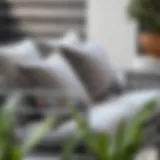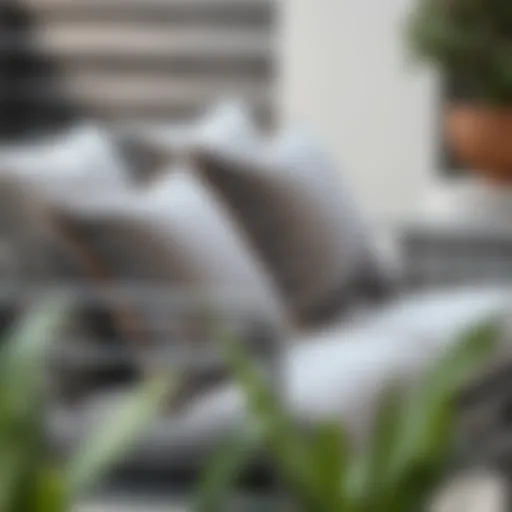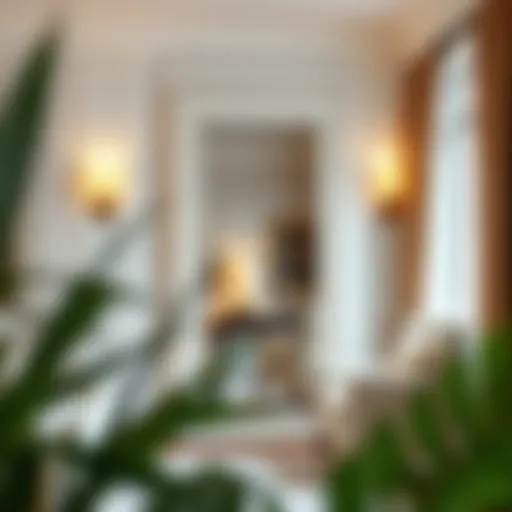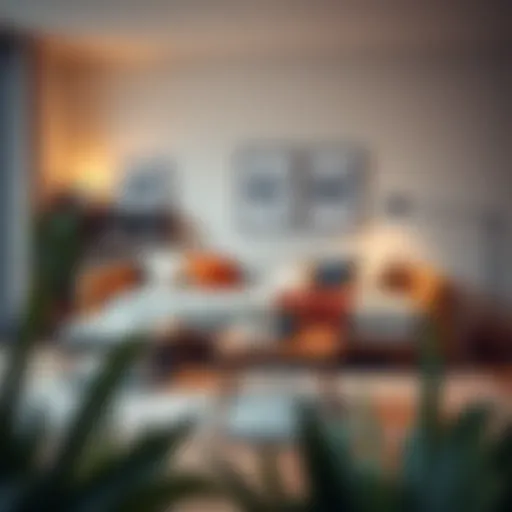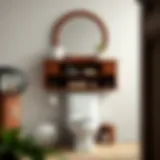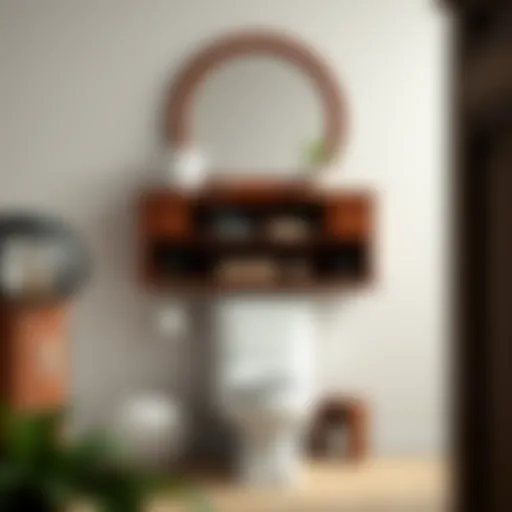Outdoor Bench Cushions: Comfort and Style Insights
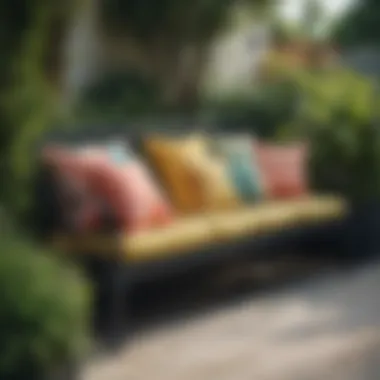

Intro
In the realm of outdoor decor, few elements hold as much potential to enhance both comfort and style as outdoor bench cushions. When considering your outdoor seating options, the size, in particular, warrants careful attention. The 47 x 18 dimensions have gained traction for their versatility, providing a balance between coziness and adequate coverage. This article explores the relevance of these cushions, discussing materials, maintenance, design considerations, and placement strategies. Plus, we’ll dive into current furniture trends and DIY approaches, allowing you to create a seating arrangement that reflects your unique taste.
Cushions do more than just provide comfort; they can transform drab outdoor spaces into welcoming retreats. But how do you select the right one? And what aspects should you focus on to ensure that your choices align with both aesthetic preferences and practical needs? Let’s embark on this exploration together.
Furniture Trends
Current Market Trends
The outdoor furniture market is experiencing a dynamic shift, driven by evolving consumer preferences. Currently, a strong emphasis is placed on durability and sustainability. Many homeowners are seeking cushions that not only look good but also withstand the test of time.
- Eco-friendly materials are on the rise. Fabrics made from recycled plastics or organic materials are becoming increasingly common. This shift reflects a growing awareness of environmental impacts.
- Bright, bold colors are trending, with deep blues and vibrant florals taking center stage. These options bring life to outdoor spaces and create inviting atmospheres.
- Textures matter. People are experimenting with different fabric weaves, giving cushions added depth and interest.
Popular Styles and Designs
When it comes to styles, there are several paths to explore. From classic to contemporary, the choices are plentiful.
- Farmhouse chic is continually in vogue, showcasing muted tones and soft, inviting fabrics.
- Modern minimalism appeals to those who prefer clean lines and neutral palettes, often paired with geometric patterns.
- Tropical themes add a playful twist, incorporating bright designs, palm leaves, and wildlife motifs.
As you ponder your cushion choices, consider the overall aesthetic of your outdoor area. Finding a cohesive style can elevate the visual appeal of your space, providing a serene environment to unwind or entertain guests.
"Cushions are not just accessories; they are the finishing touch that ties the entire outdoor ambiance together."
DIY Projects
For the hands-on homeowners and DIY enthusiasts, creating custom cushions can be a rewarding endeavor. Not only can you personalize your cushions to fit your exact dimensions, but you also have the opportunity to express your creativity.
Step-by-Step Guides
- Measure Your Bench: Accurate measurements are crucial. For a 47 x 18 bench, ensure you account for any overhang or comfort preferences.
- Select Materials: Choose weather-resistant fabrics, ideally with UV protection. Look for foam or batting that offers the best comfort.
- Cut and Sew: Use fabric scissors to cut your chosen material, leaving extra for seam allowances. Sew the edges, making sure to create a secure cover for your cushion.
- Fill the Cushions: Once the cover is ready, insert your foam or batting, ensuring a snug fit.
- Final Touches: Add any embellishments, such as ties or decorative buttons, to personalize your cushions further.
Budget-Friendly Ideas
If you’re keen on keeping costs low while still enhancing your outdoor space, consider these suggestions:
- Upcycle Old Cushions: Instead of investing in new ones, reupholster or reinvigorate older cushions with fresh fabric.
- Use Remnants: Fabric remnants from previous sewing projects can be perfect for smaller cushion covers, allowing you to mix and match patterns.
- DIY without the Sewing: No sewing skills? No problem. You can use fabric glue to stick fabric over existing cushions for a quick refresh.
Choosing the right outdoor bench cushions is more than just a shopping decision. It’s about creating a serene and stylish ambiance where you can relax and enjoy nature. Whether you pursue commercial options or engage in DIY projects, the joy of transforming an outdoor area lies in the details.
Preamble to Outdoor Bench Cushions
When it comes to enhancing outdoor living spaces, the often-overlooked aspect of comfort and style resides in the bench cushions. These cushy additions can turn a simple bench into a cozy retreat, inviting homeowners, renters, and guests alike to linger a little longer in the sunshine or under the stars. As outdoor gatherings become increasingly popular, understanding the dynamics of outdoor bench cushions becomes imperative. Not only do these cushions provide physical comfort, but they also play a pivotal role in the aesthetics of your space.
Understanding the Purpose of Bench Cushions
At their core, bench cushions are designed to offer comfort while providing support. The right cushion can make a bench not only more inviting but also elevate the entire outdoor seating experience. Whether one is sipping morning coffee or hosting an evening barbacue, having a well-cushioned bench can turn ordinary seating into something truly enjoyable.
Plus, they serve a functional purpose by providing a barrier between the hard surface of the bench and the user, reducing pressure points and creating a more enjoyable sitting experience.
Moreover, the addition of cushioning allows for personalization. The fabric, color, and pattern of the cushions can harmonize with existing outdoor decor, thus tying the various elements of your outdoor space together. This combination of comfort and design highlights their significance in enhancing the overall vibe of an area.
Defining Dimensions and Their Importance
Dimensions are not just numbers—it’s about finding the right fit for comfort and utility. The commonly preferred size of 47 x 18 inches may perfectly suit many standard benches, but it’s crucial to assess if this fits your specific seating arrangement. A cushion that doesn't fit well can slide off, create gaps, or add unnecessary bulk, detracting from both comfort and visual appeal.
When measuring your bench, take care to consider:
- Depth and Width: Make sure your cushion complements the structure without overwhelming it.
- Thickness: This affects how high you sit above the bench. Thicker cushions provide more softness but may feel less stable.
- Shape: If you have a unique-shaped bench, a tailored cushion can enhance both the form and function.
In this way, the right dimensions play a vital role in ensuring that your outdoor bench cushions are not just fashionable, but also fit seamlessly into the broader context of your outdoor space. Getting these details right can truly make or break the comfort and overall look of your outdoor seating.
Material Choices for Outdoor Bench Cushions
Choosing the right material for outdoor bench cushions isn't just about picking a pretty fabric. It's a decision that can greatly affect your comfort, the durability of the cushions, and how well they stand up against Mother Nature's whims. There are numerous materials to consider when outfitting your outdoor oasis, each offering a unique set of benefits and challenges. Striking a balance between aesthetics and functionality lies at the heart of this selection process. Let's dive into the specifics of various fabric options along with the foam and filling materials that affect both comfort and longevity.
Fabric Options: Pros and Cons
Polyester and Sunbrella Fabrics
Polyester and Sunbrella fabrics are often the go-to choices for outdoor cushions, and for good reason. These materials are tough as nails when it comes to resisting fading due to sun exposure. Sunbrella, in particular, has built a reputation for being UV-resistant and water-repellent.
The key characteristic of these fabrics lies in their ability to be cleaned easily—spill a drink? No problem! Just wipe it off, and you're back in business. Cost-wise, polyester often comes out more affordable than Sunbrella, making it a worthwhile option for budget-conscious consumers.
However, one must be aware that while polyester cushions frequently offer instant comfort, they may not have the robustness of Sunbrella over time. It’s advisable to think of how much wear and tear your cushions will experience before deciding.
Natural Fibers Like Cotton
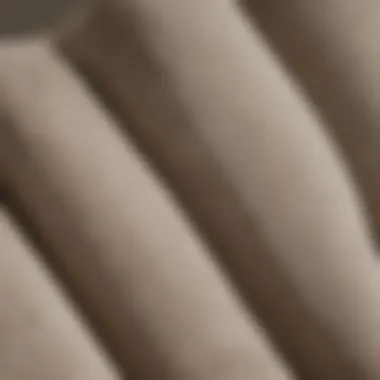

Contrasting the synthetic options, natural fibers like cotton bring a soft feel that many find irresistible. Cotton cushions typically feel cozy and inviting, making them a popular choice for relaxation.
The major downside? Cotton is not as well-suited for outdoor use. It tends to absorb water, which can lead to mildew if left out in the rain or damp conditions. If you’re looking for cushions that you’ll only use occasionally, cotton can be lovely, particularly since it comes in countless colors and patterns to suit various tastes. Just keep in mind that caring for them requires a bit more diligence.
Acrylic and Other Synthetic Materials
Acrylic cushions stand out for their unique ability to resist both mildew and fading. They’re often considered to be a bridge between the comfort of natural materials and the durability of synthetics. If you want something that won’t easily succumb to outdoor stressors, acrylic is worthy of consideration.
The beauty of using acrylic lies in its plush feel, akin to the softness of cotton while still being outdoor-friendly. While the costs may be slightly higher, the longevity and ease of care often justify the initial investment. But be cautious: not all acrylics are created equal, and some can lack breathability, potentially leading to a sticky seating experience in sweltering weather.
Foam and Filling Materials Explained
Cushion filling plays a pivotal role in determining seating comfort, affecting how cushions respond to your body weight and how quickly they return to form after use. Understanding different foam options can be a game changer for your outdoor experience.
High-Density Foam
High-density foam is frequently touted as the gold standard for outdoor cushions. Why? Because it provides exceptional support while retaining shape and firmness. This type of foam is less likely to collapse under weight, ensuring you’ll enjoy your seating for years to come.
However, with great firmness comes limited plushness. Some people might find it too rigid. It's really a balancing act; if you want endurance, this foam is fantastic, but if you’re after cloud-like softness, you might want to look elsewhere or layer it.
Polyester Fiberfill
Polyester fiberfill is a common choice that wins points for being lightweight and affordable. It has the softness that many people love, contributing to a plush, cozy seat. However, this type of filling compresses faster than high-density foam, meaning it might require more frequent replacement.
On the upside, the ease in washing and drying fiberfill makes it a favorite option for families with young kids or pets. Finding a happy medium in softness and durability can be tricky, but plenty of people appreciate the initial comfort it provides.
Memory Foam Considerations
Memory foam can also be an interesting choice for outdoor cushions, especially if you’re after ultimate comfort. Its ability to contour to your body shape means you could enjoy a relaxing lounging experience that feels tailored just for you.
However, it often struggles with breathability—how well it allows air to circulate—leading to warm seating on hotter days. It may also be pricier than other options. If you live in a milder climate, memory foam can be a delight. But for those facing scorching summers, you might want to think it over.
"Sometimes, the cushion you choose can end up playing a leading role in how you enjoy your outdoor retreat—comfort is not merely a luxury; it’s an integral part of the experience."
In summary, each material and filling choice brings its own set of pros and cons. Whether you prioritize durability, comfort, or aesthetics, there’s a solution that aligns with your needs. With a bit of consideration, you can turn a simple outdoor bench into a favorite spot for relaxation and leisure.
Measuring and Selecting the Right Size
When it comes to outdoor bench cushions, size is more than just a number. It plays a critical role in both comfort and aesthetic appeal. Ensuring you have the right dimensions can make or break your outdoor relaxation experience. Size impacts how snugly the cushion fits your bench, how comfortable you feel sitting on it for extended periods, and how well it integrates with the overall design of your outdoor space.
Why Size Matters for Comfort
A cushion that's too small leaves you feeling like you're sitting on a slab of wood, while one that's too big may look out of place and lead to slippages or awkward weight distribution. The cushion should properly support your body, encouraging good posture and comfort. Consider a few points:
- Support: A well-fitted cushion contributes to better back support.
- Aesthetic Balance: An oversized cushion can give a cluttered look, while one that's too tiny can feel sparse.
- Durability: Properly sized cushions experience less wear over time since they can better align with the bench's surface.
Therefore, achieving the right size is a blend of function and style. If you're not comfy, you're not going to sit out there long enough to enjoy the sunshine!
Best Practices for Measuring Your Bench
So, how do you ensure you're getting the right fit for your cushion? Here are some best practices that can help you make accurate measurements:
- Gather Your Tools: A simple tape measure, a notepad, and maybe a friend can work wonders.
- Take Multiple Measurements: Always measure the length, width, and depth of your bench. It can change depending on where you measure, especially if your bench has curves.
- Account for Any Obstacles: If there’s a backrest or armrests, measure around these areas. Ensure your cushion doesn’t overlap or get wedged in a way that’s awkward.
- Understand Your Desired Look: Consider how "plump" you want your cushion to be—some prefer them to be thicker, while others might favor a more minimalist approach.
- Fit and Finish: Remember that cushions might shift slightly when sat upon. Aim for a snug yet comfortable fit.
- Stay Consistent: Write down your measurements and any extra considerations for when you actually purchase the cushion.
- Length: Measure from one end to the other.
- Width: Measure from the front to the back.
- Depth: If applicable, measure how deep the bench is for a snug fit.
"Measuring correctly saves you time and potential frustration when it comes to buying cushions. A minute spent accurately measuring saves hours in returns or uncomfortable seating."
Following these best practices will not only simplify your shopping experience but also boost your chances of finding a cushion that blends effortlessly into your outdoor environment.
Cushion Style and Design Options
The style and design of outdoor bench cushions can make or break the overall impact of your seating area. They not only serve as a comfort enhancer but also as crucial design elements that contribute greatly to the ambiance of an outdoor space. Selecting the right cushion style involves considering factors such as color, shape, and print, which can effectively transform a basic bench into an appealing focal point in your garden or patio. Ultimately, these options go beyond aesthetics—your cushion choices can reflect personal style and influence mood.
Exploring Color and Pattern Choices
Selecting colors and patterns for outdoor cushions is about finding a balance between personal taste and the environment around you.
Solid Colors for Minimalist Aesthetics
Solid colors are often the go-to for those seeking a clean, minimalist aesthetic in their outdoor areas. The power of a simple, unified color can provide a calming atmosphere that lets other decor elements shine. For instance, a cushion in a muted earth tone can blend seamlessly with natural surroundings, creating a serene space.
- Key characteristic: Minimalism tends to favor simplicity, adding an air of sophistication.
- Popular choice: Their versatility allows them to suit various styles, from traditional to modern.
- Unique feature: Solid colors make it easy to mix and match with other decor, such as throws or decorative pillows.
- Advantages: Harmonizes with surrounding decor and reduces visual clutter.
- Disadvantages: They may not stand out as much in vibrant environments.
Patterns That Make a Statement
For those eager to express personality, patterned cushions can add vibrancy and character to outdoor spaces. A bold geometric print or floral design can inject energy into an otherwise neutral setting.
- Key characteristic: Patterns draw the eye and serve as conversation starters.
- Popular choice: They often reflect trends, making them perfect for those who enjoy staying up-to-date with design developments.
- Unique feature: Patterns can either complement or contrast with other outdoor elements, allowing for dynamic decor.
- Advantages: Can brighten up a dull area instantly.
- Disadvantages: Choosing the wrong pattern can clash with existing decor, leading to a chaotic look.
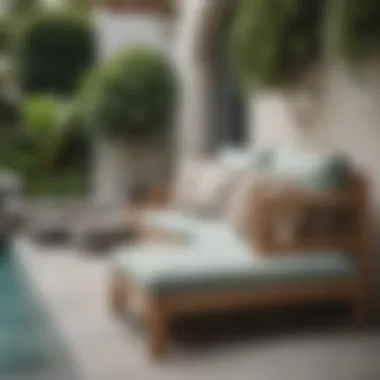

Seasonal Variations in Design
Finding ways to freshen up your outdoor setting throughout the changing seasons is vital. Seasonal cushion designs allow homeowners to embrace the full beauty of nature, creating a warm invite no matter the time of year.
- Key characteristic: Seasonal designs often lead to better engagement with outdoor spaces, encouraging more time spent outside.
- Popular choice: Many opt for lighter colors in summer and richer, warm shades during fall to create a cozy vibe.
- Unique feature: Switching cushions based on the season also makes it easy to refresh your outdoor decor without significant investment.
- Advantages: Keeps spaces looking trendy and ensures that the ambiance corresponds with the weather.
- Disadvantages: May require additional storage to keep off-season cushions protected from the elements.
Shape Variations and Their Impact
The shape of a cushion can dramatically affect both comfort and style in outdoor seating. Certain shapes cater to specific bench designs while influencing how people utilize the space.
Traditional Rectangular Cushions
Rectangular cushions have long been the standard choice for outdoor benches. Their straightforward design offers ample seating space and aligns seamlessly with most bench structures.
- Key characteristic: Universally recognizable, making them widely available in various patterns and colors.
- Popular choice: Their practicality fits well in many outdoor settings.
- Unique feature: They can be easily layered with smaller cushions for added comfort and decoration.
- Advantages: Simple to find replacements if they wear out or get stained.
- Disadvantages: May seem too predictable for those looking for something unique.
Custom Shapes for Unique Benches
Custom-shaped cushions provide a tailored solution for benches that don’t conform to standard dimensions. This option allows for personalization, ensuring a snug fit while enhancing the overall aesthetics of the outdoor space.
- Key characteristic: Custom shapes can follow unique bench contours or create playful seating arrangements.
- Popular choice: They support a more eclectic or individual style, reflecting the owner’s personality.
- Unique feature: Easier to fit into corners or around structures, optimizing the available space.
- Advantages: Provide maximum comfort by ensuring better alignment with body shapes.
- Disadvantages: Typically require a more considerable investment, both in time and financial resources, for the custom design process.
In summary, cushion style and design are essential aspects of enhancing outdoor comfort and aesthetics. By carefully considering color, pattern, and shape, individuals can create inviting environments that resonate with their unique tastes and preferences.
Maintenance and Care for Outdoor Cushions
Keeping outdoor cushions in tip-top shape ain’t just about appearances; it ensures longevity, comfort, and retains the cushion’s aesthetic charm. Just like any other piece of outdoor furniture, cushions are subjected to weather conditions, spills, and general wear and tear. Therefore, investing time in maintenance is paramount. Not only does it enhance your seating experience, but it also contributes to overall outdoor aesthetics, ensuring spaces remain inviting and pleasant.
Essential Cleaning Techniques
Machine Washing and Hand Cleaning
When it comes to cleaning outdoor cushions, knowing whether to toss them in the washing machine or give them a good scrubbing by hand can make a world of difference. Generally, machine washing is the go-to for many homeowners. The convenience of simply loading these cushions into the washing machine saves time. It's often a quick process that can remove dirt and allergens effectively.
However, not all materials are created equal. Some fabrics, particularly delicate ones, may unravel if exposed to the agitation of a washing machine. This is where hand cleaning plays its part—especially for those cushions made of natural fibers or specialized fabrics.
Key Characteristics of Each Cleaning Method:
- Machine Washing:
- Hand Cleaning:
- Quick and efficient.
- Best for synthetic fabrics like polyester, which tend to hold up well.
- May damage delicate fabrics over time.
- Gentle approach, ideal for sturdier fabrics.
- You can control the amount of pressure applied while washing, reducing the risk of damage.
- Time-consuming compared to machine washing, which may deter some.
Removing Stains Effectively
Stains are an inevitable part of life, especially with outdoor seating. Knowing how to tackle them effectively is crucial. First off, it’s wise to act quickly; the sooner you address a spill, the easier it is to clean. A simple mix of mild soap and water usually works wonders, but specific stains may require specialized cleaning solutions tailored to the stain type. For example, grease stains need a different approach than coffee or red wine.
Highlighting Key Characteristics:
- Swift action is paramount.
- Utilizing the right cleaning agent can save your cushions from permanent marks.
- Having a designated stain remover on hand ensures you’re prepared.
Storage Solutions to Extend Lifespan
Proper storage significantly extends the life of outdoor cushions, especially during unfavorable weather or the colder months. Defining storage practices not only protects cushions from elements but also prevents mold and mildew buildup, both of which can contribute to a less pleasant outdoor seating experience.
Best Practices for Seasonal Storage
The importance of seasonal storage cannot be overstated. For instance, a simple practice of cleaning the cushions before storing can keep them fresh and ready for when warm weather rolls in again. Storing them in a dry, cool location can also guard against pests like moths or rodents.
Key Characteristics and Benefits:
- Cleaning before storage prevents stains from becoming permanent.
- A dry, cool environment limits mold growth.
- Seasonal storage eliminates the need for frequent replacements, saving money in the long run.
Choosing the Right Storage Containers
Selecting appropriate containers is just as essential as the method of storage. Utilizing breathable storage bags or boxes can protect cushions without trapping moisture. Avoid plastic wraps or non-breathable containers, as they can create a conducive environment for mold growth.
Highlighting Unique Features:
- Breathable fabrics allow air circulation, which helps prevent mustiness and mildew.
- Containers should ideally have enough space to prevent compression, as this could damage the cushion’s filling over time.
- Investing in quality storage options is crucial for the longevity of your cushions.
To maximize the lifespan of outdoor cushions, remember: a little maintenance goes a long way. Proper care and storage not only keep them looking fresh but also ensure they remain comfortable and secure for your outdoor gatherings.
Sustainable Choices in Cushion Manufacturing
In recent years, the importance of sustainability has seeped into nearly every aspect of manufacturing, and outdoor bench cushions are no exception. As the conversation around environmental issues grows louder, consumers are increasingly seeking products that align with eco-friendly practices. This interest in sustainability isn't merely a trend; it's a shift in values. Choosing cushions that are manufactured with sustainable practices can lead to lower environmental impact, contributing to a healthier planet for future generations.
Choosing eco-friendly cushions isn't just a matter of making the right choice; it's also about influencing the market. When consumers opt for sustainable products, manufacturers take notice. This creates a ripple effect in the industry, prompting companies to prioritize sustainable practices and materials. More than just personal satisfaction, these choices can drive positive change on a broader scale, affecting everything from production methods to waste management.
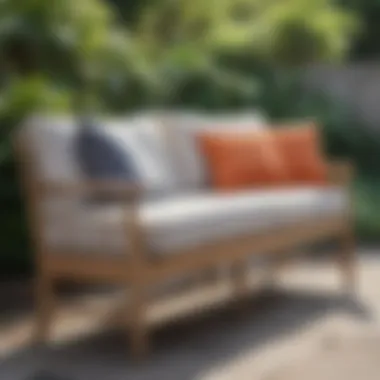

Understanding Eco-Friendly Materials
When we talk about eco-friendly materials, it’s essential to delve into what makes a material truly sustainable. For outdoor bench cushions, several key characteristics define eco-friendliness:
- Renewability: Materials derived from renewable resources often have a lesser environmental footprint. For example, organic cotton and hemp are good options. They replenish naturally and minimize soil depletion during cultivation.
- Biodegradability: Some materials will break down naturally without leaving harmful residues. Natural fibers like jute and bamboo would fall under this category.
- Recycled Materials: Items made from recycled content, such as recycled polyester, can significantly lessen waste. They give a new life to materials that would otherwise add to landfill clutter, reducing the demand for virgin resources.
- Non-Toxic Finishes: It's necessary to consider the chemical processes involved in treating materials. Non-toxic dyes and finishes can be significantly better for the environment than their synthetic counterparts.
The Impact of Sustainable Practices
Beyond just the materials used, the entire manufacturing process can play a tremendous role in sustainability. Here are some of the impacts involved when companies prioritize sustainable practices:
- Reduced Carbon Footprint: By opting for sustainable energy sources and more efficient production methods, manufacturers can significantly lessen their carbon footprint. This is especially true for companies that utilize solar or wind energy.
- Conservation of Resources: Sustainable practices often result in less waste. For instance, companies might implement measures like using water-efficient processes or recycling production scraps to minimize resource depletion.
- Long-lasting Products: When cushions are made with quality, eco-friendly materials, they tend to last longer, leading to less frequent replacements. This longevity translates to a lower overall environmental impact.
- Community Benefits: Many sustainable companies maintain ethical labor practices, ensuring fair wages and safe working conditions. Supporting these businesses means contributing to more equitable employment practices.
"Sustainability isn't simply a trend; it's a commitment to making choices that reflect our values."
Ultimately, embracing sustainable choices in outdoor bench cushions combines both personal comfort and environmental stewardship. By understanding eco-friendly materials and the broader impact of sustainable practices, homeowners, renters, and DIY enthusiasts can make informed decisions that enhance both their outdoor aesthetics and ecological responsibility.
Incorporating Cushions in Outdoor Spaces
When it comes to outdoor living, incorporating cushions plays a pivotal role. They serve more than just as comfort enhancers; they redefine the ambiance and functionality of outdoor areas. The best cushions transform hard benches into inviting spots, perfect for relaxation or lively gatherings. Their practical benefits stand alongside aesthetic appeal, making them an essential element of outdoor decor.
Strategically placed cushions can significantly heighten the overall comfort of your bench. This not only elevates the experience of lounging outdoors but also makes your space more inviting for guests. Considering the arrangement and color choices of your cushions can truly influence the vibe, turning an ordinary bench into a cozy nook.
Strategic Placement for Maximum Comfort
Arranging Cushions on Different Furniture Types
When tackling arranging cushions on various furniture types, think about how to optimize comfort. Each furniture piece has its distinctive shape, size, and height, and cushions can adapt to these variations beautifully. For instance, a curved lounge chair demands a different cushion arrangement than a straight bench.
This adaptability is fundamental – cushions complementing your furniture types not only add comfort but also enhance the overall coherence of your outdoor space. A key characteristic here is versatility; cushions can fit snugly on traditional benches, align perfectly with modern loungers, or even work their magic on patio chairs.
One unique feature of arranging cushions is that it invites experimentation. Homeowners can play with sizes, shapes, and colors. The danger? It may sometimes result in a mismatched look if not thoughtfully approached. Yet, the benefits generally outweigh these risks, since a well-arranged cushion selection can provide tailored support while visually balancing your furniture layout.
Creating Inviting Lounge Areas
Now, let’s turn to creating inviting lounge areas. The vision here is to foster a space where relaxation and social interaction can flourish. Cushions play a supporting role in this setup by adding essential coziness.
A key thing to know is that comfortable setups naturally draw people in. Well-placed cushions can beckon guests to sit down and unwind, which is the essence of any good outdoor lounge area. It’s most effective when cushions are arranged not just for looks but for optimal lounging.
Think about utilizing larger, plush cushions for ground seating. They can foster a communal feel, making conversations more intimate. On the flip side, the unique feature of creating inviting spaces is that it also accepts personalized touches. You can layer different cushion textures for a plush experience, or even mix patterns to add a dash of individuality. Sometimes, though, layering can make the area feel overwhelming, so it’s wise to strike a balance.
Enhancing Aesthetic Appeal of Your Outdoor Area
Combining Colors with Surrounding Decor
Let’s move to the colorful realm of combining colors with surrounding decor. This aspect is integral to achieving a harmonious outdoor look. Cushions can effectively tie together different elements of your environment, pulling the entire scene into a cohesive snapshot of style.
What tends to stand out is how well-chosen colors can either contrast or complement the existing surroundings. For instance, bright cushions can pop against muted furniture, creating a vibrant focal point. Alternatively, using softer tones can help the cushions blend seamlessly with nature, establishing a tranquil retreat.
One thing to remember: choosing colors isn’t just about preferences. It’s about matching the mood of your space. If you’re after a serene garden vibe, go with cool blues or greens. But for a lively, energetic atmosphere, bolder reds and yellows can do the trick. The downside? If not coordinated well, it may lead to a chaotic feel that detracts from the beauty of your outdoor area.
Utilizing Cushions in Various Settings
Finally, let’s explore utilizing cushions in various settings. It’s interesting to note how adaptability here can transform any outdoor area. Cushions can be positioned on benches, sofas, or even as standalone seating on the ground, showcasing their multifunctionality.
The characteristic of this utilization is flexibility; you can redefine spaces based on occasion. For example, scattered cushions can turn a simple patio into a festive gathering space, while neatly arranged cushions can serve well for formal settings. The unique feature of versatility is that cushions can pivot from casual lounging to formal entertaining with relative ease.
However, with great versatility comes management. If cushions move around too much, they can disrupt the aesthetic flow. Nevertheless, with careful thought to placement and choice, they can effectively enhance both functionality and style in your outdoor settings.
"Cushions are the unsung heroes of outdoor spaces, offering comfort and style that can truly elevate your experience."
In summary, incorporating cushions into outdoor spaces enriches both comfort and aesthetics. Through strategic placement, color coordination, and appropriate utilization, they have the power to elevate an ordinary area into a welcoming paradise.
Closure: Finding the Right Outdoor Bench Cushion
In wrapping up this exploration of outdoor bench cushions, it's essential to understand how crucial the right cushion is in achieving both comfort and style in your outdoor living spaces. Your choice of bench cushions significantly affects how welcoming and functional your area is. Whether it’s a sun-drenched patio, a shaded garden nook, or a cozy balcony, the right cushions can elevate these spaces to new heights.
To shed light on this, let’s consider some specific elements that come into play with outdoor bench cushions. Firstly, dimensions, such as the commonly sized 47 x 18, are vital. Selecting cushions that fit your furniture perfectly ensures not only comfort but also visual cohesion. A mismatch can easily throw off the aesthetic harmony, making a beautiful setup seem haphazard.
Another important facet to consider is the materials from which your cushions are made. As we've discussed, outdoor cushions need to withstand the elements while providing a soft, cozy feel. Look for options that combine resilience with comfort, such as Sunbrella fabrics or high-density foam—both of which blend functionality with style.
Then there’s the design aspect. The right patterns and colors can add personality and charm to your outdoors. Perhaps you opt for vibrant colors that stand out against greenery, or muted tones that invite relaxation. The design plays a pivotal role not just in comfort, but also in how appealing your outdoor space is to guests and family alike.
Finally, sustainability should not be overlooked. Choosing eco-friendly materials and manufacturers who adhere to sustainable practices not only benefits the environment but also aligns with a growing trend among environmentally conscious consumers.
"The right cushions can transform a simple bench into a statement piece that invites relaxation and conversation."
By considering these elements together—fit, material, design, and sustainability—you will be better prepared to find the perfect outdoor bench cushion to suit your needs.
Key Takeaways from the Comprehensive Guide
- Dimensions and sizes are critical for both comfort and appearance.
- The choice of materials affects the longevity and aesthetic of the cushions.
- Design elements such as color and pattern can set the tone of your space.
- Sustainable practices enhance not only the style but also the ethical impact of your purchase.
- Proper placement and care further maximize the cushions’ effectiveness and lifespan.
Final Thoughts on Outdoor Comfort
Finding the right outdoor bench cushion is not merely a functional choice—it's about enhancing your lifestyle. An inviting outdoor seating area can become an extension of your home, a place to unwind, entertain friends, or simply enjoy some quiet time with nature. As you reflect on the guide provided, remember that thoughtful selection based on comfort, style, and sustainability will create an outdoor haven that complements your personal taste and lifestyle. Take the time to explore the possibilities, and you’ll discover that the right cushions do much more than add comfort; they can transform your outdoor space into a sanctuary.


